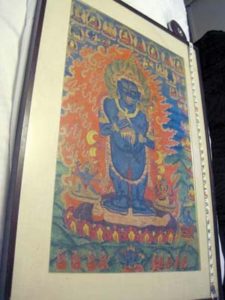 K and A sent me this Tibetan Thangka, at 2 x 3 feet, a gouache on fabric. Gouache is a medium more opaque than watercolor, with the addition of a white (chalk) based color, which you won’t find in watercolors. A Thangka is a Buddhist devotional image mounted on silk and covered, when not gazed upon, with silk. Because of this display technique, some Thangkas have lived 400 years.
K and A sent me this Tibetan Thangka, at 2 x 3 feet, a gouache on fabric. Gouache is a medium more opaque than watercolor, with the addition of a white (chalk) based color, which you won’t find in watercolors. A Thangka is a Buddhist devotional image mounted on silk and covered, when not gazed upon, with silk. Because of this display technique, some Thangkas have lived 400 years.
Some of the more favored Buddhist images for Thangkas are the Wheel of Life, Buddhist Myths, Deities, the Bodhisattvas, and favorite scenes from the Life of Buddha. Some Buddhist traditions, such as Vajrayana, use their Thangkas to facilitate meditation, sinking into the good characteristics of the Deity pictured.
Mahakala the Protector Thangka
K and A wrote that they don’t know a thing about this funny man is. This image shows Mahakala – the great protector – but not as benign as you might think. Let’s look at the iconography of your Thangka to understand which Deity entered your life. Mahakala, a wrathful guy, stands on top of a prostrate figure, he holds a cleaver and a skull in a pair of his four arms. Around his head lays a garland of severed heads, a skull tiara, surrounded by flames. Mahakala stands surrounded by human-like representations of his inner circle, of his own lineage: Trakshe, Lord of the Demons, and Shri Devi. Among other deities in Mahakala’s retinue, Mahakala’s teachers float above his head. His stance, “alidhasana,” represents a conquering stride. Underneath him sits the eternal lotus. How can such a deity be a protector, you might ask? He looks more like a destroyer.
The answer? Forget your “Western” training when looking at an image from another culture. Western religion teaches that an image represents either wicked or angelic, but in Eastern iconography, an image can contain both polarities. Your Mahakala is both protector and destroyer. Appropriately, he has four faces and three eyes to each face to prove his vigilance, along with his bared fangs. Think of this Thangka as a musical score with different registers to sing to us different aspects of Mahakala’s personality. For example, in the upper register this Deity incarnations had many teachers and predecessors. The tradition of painting this Deity in this style of imagery tells the devout the same story of Mahakala, a story going back to a beloved Yogi in the 11th century, Khyungpo Nalijor.
Lord of Time
The Buddhist Mahakala is a descendant of the Hindu god Shiva, who also characterizes preservation and destruction. Like Mahakala, he is the Lord of Time, which destroys and creates all things. Centered in the belief of eternal rebirth, Mahakala represents the “circle of time” visually with his round coiled snake around his neck. Snakes suggest reincarnation. Its natural process of molting and shedding their skin is symbolic of a human soul’s transmigration through many bodies from one life to another.
K and A, if your Thangka originated in the 17th or 18th century. we’d see less bright colors and more detail. We’d talk about a value, in good condition, of $10,000-20,000. A 19th century Mahakala, would bring $5,000-10,000. But yours, firmly 20th century with unexceptional detail, strident colors, and stiff rendering, I’d value at $200-300.
Hello. I have an ancient thangka bought from a dealer overseas. They painted it in actual gold I am told and I think it’s worth a lot, but I don’t have a way of knowing how valuable it might be. It’s framed and in good condition and I would like to sell it. Can you give me any guidance? Thank you.
Can you do rough appraisals by photo.